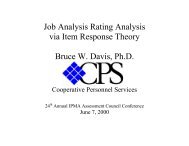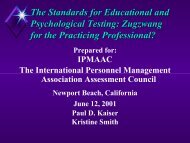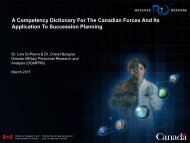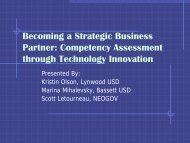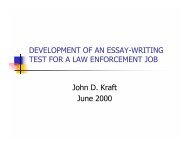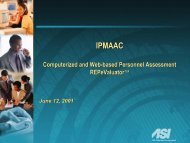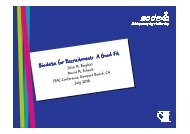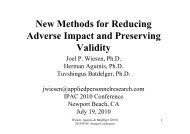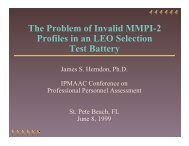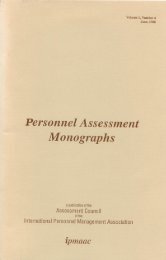How to Tailor Your Recruitment and Selection Process to ... - IPAC
How to Tailor Your Recruitment and Selection Process to ... - IPAC
How to Tailor Your Recruitment and Selection Process to ... - IPAC
You also want an ePaper? Increase the reach of your titles
YUMPU automatically turns print PDFs into web optimized ePapers that Google loves.
<strong>How</strong> <strong>to</strong> <strong>Tailor</strong> <strong>Your</strong><br />
<strong>Recruitment</strong> <strong>and</strong><br />
<strong>Selection</strong> <strong>Process</strong> <strong>to</strong><br />
Reflect a Changing<br />
Economy<br />
Presented by
Agenda<br />
CPS HR Services – background information<br />
<strong>How</strong> the economy drives c<strong>and</strong>idate pools<br />
Current trends in Merit System Services (MSS)<br />
<strong>How</strong> MSS tailored its selection process when:<br />
• C<strong>and</strong>idate numbers were low<br />
• C<strong>and</strong>idate numbers were high<br />
<strong>How</strong> we streamlined our MSS processes<br />
MSS <strong>Process</strong> Improvements
Agenda cont.<br />
<strong>Recruitment</strong> <strong>and</strong> <strong>Selection</strong> Survey<br />
<strong>Tailor</strong>ing an assessment center based<br />
on the size of the c<strong>and</strong>idate pool<br />
Legal implications <strong>to</strong> keep in mind when<br />
modifying the selection plan<br />
References<br />
Questions <strong>and</strong> answers
His<strong>to</strong>ry<br />
Cooperative Personnel Services<br />
was a unit of the California State<br />
Personnel Board (SPB) which was<br />
developed in 1935 <strong>to</strong> provide<br />
personnel management assistance<br />
<strong>to</strong> governmental entities in<br />
California.<br />
CPS Human Resource Services<br />
was created as a joint-powers<br />
agency in 1985 as a result of the<br />
separation of the Local Government<br />
Services Division from SPB.
Established with an intent <strong>to</strong>…<br />
Act as a change agent <strong>and</strong> resource <strong>to</strong><br />
encourage intergovernmental cooperation in<br />
technical personnel areas.<br />
Provide tailored consulting services <strong>to</strong> public<br />
agencies <strong>and</strong> non-profit organizations.<br />
Provide technical training for persons involved<br />
in public personnel management.<br />
Increase <strong>and</strong> support the development <strong>and</strong> use<br />
of validated selection programs.<br />
Support research in the field of public personnel<br />
selection <strong>and</strong> management.
Mission<br />
Provide professionally<br />
sound, client-oriented<br />
human resources <strong>and</strong><br />
related products <strong>and</strong><br />
services <strong>to</strong> public <strong>and</strong><br />
nonprofit clients.<br />
Our driving vision is <strong>to</strong><br />
improve human<br />
resources in the public<br />
sec<strong>to</strong>r.
Merit System Services (MSS)
Merit System<br />
Services<br />
Subdivision of CPS that<br />
has been awarded the<br />
Merit contract by the<br />
State Personnel Board.<br />
Oversees <strong>and</strong> directly<br />
administers personnel<br />
programs for Social<br />
Services, Child Support,<br />
<strong>and</strong> Emergency Services<br />
programs.
Local Agency Personnel<br />
St<strong>and</strong>ards (LAPS)<br />
These are the rules that govern the employees in<br />
the Merit System Service.<br />
Adopted by the State Personnel Board <strong>to</strong> implement<br />
Government Sections 19800-19810, which require<br />
establishment of personnel st<strong>and</strong>ards in regula<strong>to</strong>ry<br />
form necessary “<strong>to</strong> assure state conformity with<br />
applicable federal requirements.”<br />
Merit Principle 1, Section 17110 states that<br />
recruiting, selecting, <strong>and</strong> advancing employees shall<br />
be on the basis of their relative ability, knowledge<br />
<strong>and</strong> skills, including open consideration of qualified<br />
applicants for initial appointment.
<strong>How</strong> the Economy Drives<br />
C<strong>and</strong>idate Pools<br />
Strong Economy –<br />
• Increased number of new businesses<br />
developed<br />
• Increased number of jobs<br />
• Less layoffs/downsizing<br />
• Not enough qualified applicants <strong>to</strong> fill jobs<br />
• Increased competitiveness for talent<br />
• Private sec<strong>to</strong>r benefit plans may become<br />
more attractive
<strong>How</strong> the Economy Drives<br />
C<strong>and</strong>idate Pools<br />
Poor Economy –<br />
• Increased layoffs/downsizing<br />
• Decreased development of new<br />
businesses<br />
• Not enough jobs for all of the applicants<br />
• Applicant pool tends <strong>to</strong> be better qualified<br />
• Public sec<strong>to</strong>r employment <strong>and</strong> benefit<br />
plans become more attractive
Current Trends in Merit<br />
System Services<br />
• 2000 – Unemployment rate was 4.95%<br />
<strong>and</strong> CPS received 2,391 applications in the<br />
last quarter of fiscal year.<br />
• 2002 – Unemployment escalated <strong>to</strong> 6.68%<br />
<strong>and</strong> CPS received 4,879 applications in the<br />
last quarter of fiscal year.<br />
• Increase in number of applications by<br />
104%.
<strong>How</strong> We <strong>Tailor</strong>ed our <strong>Recruitment</strong> <strong>and</strong><br />
<strong>Selection</strong> <strong>Process</strong> <strong>to</strong> Accommodate a<br />
Strong Economy (Decreased Applications)<br />
Requires creative recruitment analysts <strong>to</strong><br />
attract qualified c<strong>and</strong>idates<br />
Increase Outreach Efforts:<br />
• Job fairs<br />
• Attend meetings/events<br />
• Attend workshops<br />
• Work with an advertising firm<br />
• Advertise outside the mainstream<br />
• Sell the profession<br />
• Continuous recruitments
<strong>How</strong> We <strong>Tailor</strong>ed our <strong>Recruitment</strong> <strong>and</strong><br />
<strong>Selection</strong> <strong>Process</strong> <strong>to</strong> Accommodate a<br />
Strong Economy (Decreased Applications)<br />
• Reduce non-value added test components:<br />
Eliminate supplemental questions unless they<br />
are needed <strong>to</strong> determine qualifications.<br />
• Increase c<strong>and</strong>idate communication throughout<br />
recruitment period <strong>to</strong> keep them engaged:<br />
Allow for oral examinations <strong>to</strong> occur via<br />
conference call.<br />
Allow flexibility in exam scheduling.<br />
Schedule hiring interviews directly after oral<br />
exam.
<strong>How</strong> We <strong>Tailor</strong>ed our <strong>Recruitment</strong> <strong>Process</strong><br />
<strong>to</strong> Accommodate a Weak Economy<br />
(Increased Applications)<br />
Requires creative recruitment analysts <strong>to</strong><br />
identify qualified c<strong>and</strong>idates.<br />
Decrease recruitment period.<br />
Use promotional recruitments.<br />
Require the completion of supplemental<br />
questions.<br />
Implement a secondary screening based on<br />
education <strong>and</strong>/or experience.<br />
Use multiple hurdle examination process.<br />
This could be a time that is spent streamlining<br />
process.
<strong>How</strong> We Streamlined Our<br />
<strong>Process</strong>es<br />
Au<strong>to</strong>mation:<br />
• Requisition forms<br />
• Class Specifications<br />
Improve the online application process making<br />
it more user friendly.<br />
Gain capability <strong>to</strong> scan <strong>and</strong> score written tests<br />
internally.<br />
Enhance pool of oral examination questions.<br />
Provide immediate notification <strong>to</strong> c<strong>and</strong>idates<br />
that application has been approved.<br />
Place ads on a regional basis when applicable.
<strong>How</strong> We Streamlined Our<br />
<strong>Process</strong>es (Cont.)<br />
Use updated bulletins that are more<br />
streamlined, tailored <strong>to</strong> positions, <strong>and</strong><br />
easier <strong>to</strong> read.<br />
Work closely with departmental contacts<br />
<strong>to</strong> set recruitment timeframes instead of<br />
following a st<strong>and</strong>ard timeframe.<br />
Capture ad costs <strong>to</strong> reevaluate costeffectiveness.<br />
Email copies of certification lists.
MSS <strong>Process</strong> Improvements<br />
The average calendar days <strong>to</strong> complete<br />
each step for a period of 6 months in<br />
2002 compared <strong>to</strong> the same 6-month<br />
period in 2004:
Results of <strong>Process</strong> Improvement<br />
<strong>Process</strong> Step 2002<br />
Days <strong>to</strong><br />
Complete<br />
2004<br />
Days <strong>to</strong><br />
Complete<br />
Days of<br />
Improvement<br />
From receipt of requisition <strong>to</strong> list<br />
certified when written exam only<br />
64.5 49.8 14.7<br />
From receipt of requisition <strong>to</strong> list<br />
certified when oral exam only<br />
74.8 63.2 11.6<br />
From receipt of requisition <strong>to</strong> list<br />
certified when two part exam i.e.,<br />
written plus oral<br />
90.6 77.6 13
<strong>Recruitment</strong> <strong>and</strong> <strong>Selection</strong><br />
Survey<br />
Purpose<br />
• To identify what other agencies have been doing in<br />
their recruitment <strong>and</strong> selection processes <strong>to</strong><br />
account for the changing economy.<br />
• Wanted information in terms of strategies <strong>and</strong><br />
processes used or changed over the past few<br />
years in order <strong>to</strong> account for the change in the<br />
economy, the number of applications, <strong>and</strong> the<br />
number of qualified applicants.<br />
Sent <strong>to</strong> WR<strong>IPAC</strong> <strong>and</strong> CPAAC members.
<strong>Recruitment</strong> <strong>and</strong> <strong>Selection</strong><br />
Survey<br />
Respondents<br />
• 23 Cities, Counties, <strong>and</strong> Special Districts.<br />
• Siskiyou County, Marin County, Yuba County, San<br />
Joaquin County, Kings County, Santa Clara<br />
County, Lassen County, San Diego County,<br />
Bassett Unified School District, City of Corona, AC<br />
Transit District in Oakl<strong>and</strong>, City of Carlsbad, San<br />
Bernardino City Unified School District, City of<br />
Santa Barbara, City of Ventura, City of Las Vegas,<br />
City of Los Angeles, East Bay MUD, City of<br />
Torrance, County of Sacramen<strong>to</strong>, City of<br />
Woodl<strong>and</strong>, City of Yuba, <strong>and</strong> Placer County.
Q 1a: Has your agency experienced an<br />
increase in the volume of applications <strong>and</strong><br />
qualified applicants in the past few years?<br />
Results:<br />
• Yes: 15 agencies<br />
• No: 6 agencies<br />
• 2 agencies responded with “it depends on<br />
the position being recruited for”
Q1b:If “yes” what has your agency done <strong>to</strong> modify<br />
its recruitment <strong>and</strong> selection processes <strong>to</strong> account<br />
for the flux in the number of applications <strong>and</strong><br />
identify the most qualified?<br />
Results<br />
• Emphasize the most important qualifications or skills for that<br />
position on the job announcement.<br />
• Added supplemental questionnaires, conduct testing prior <strong>to</strong><br />
the closing date.<br />
• Eliminated subjective criteria such as oral boards - also<br />
minimized testing unless experience clearly indicates the<br />
test would effectively help rank our applicants.<br />
• In ads <strong>and</strong> in the online application, we tell job seekers NOT<br />
<strong>to</strong> apply if they do not meet the minimum qualifications.
Q1b: Results cont.<br />
• We have held more written tests.<br />
• Check box style supplemental applications <strong>to</strong> facilitate easy<br />
application screening.<br />
• Our recruitment processes have not changed.<br />
• We have increased our use of T& Es <strong>and</strong> supplemental<br />
questionnaires.<br />
• Less media - more targeted recruitment for desirable<br />
qualifications.<br />
• Supplemental applications; screen based on desirable<br />
qualifications; targeted recruitments; current employees<br />
word of mouth (we have a referral incentive program).<br />
• Added on-line recruiting <strong>and</strong> application process.
Q2: Which recruitment <strong>and</strong> selection strategies have<br />
you found <strong>to</strong> be most useful in identifying the most<br />
qualified c<strong>and</strong>idates when applications are plentiful?<br />
Results:<br />
• Use one-day filings.<br />
• Written examination process works best. (multiple)<br />
• Minimum qualifications <strong>and</strong> T&Es. (multiple)<br />
• Supplemental questionnaires. (multiple)<br />
• Use of minimum <strong>and</strong> preferred qualifications for ranking.<br />
• Tell c<strong>and</strong>idates they are for example "1 of 250<br />
c<strong>and</strong>idates who are being invited <strong>to</strong> the written exam."<br />
• Have increased the number of people involved in the<br />
screening process who have ample knowledge of the<br />
basic qualifications of the position.
Q3: Which recruitment <strong>and</strong> selection strategies<br />
have you found <strong>to</strong> be most useful in identifying the<br />
most qualified c<strong>and</strong>idates when applications are<br />
scarce?<br />
Results<br />
• Extended deadlines.<br />
• Reopened recruitments.<br />
• Open <strong>and</strong> continuous filings. (multiple)<br />
• Focused advertising in trade journals, job fairs, police<br />
academies, <strong>and</strong> trade shows. (multiple)<br />
• Recent college graduates we are willing <strong>to</strong> train someone<br />
with less experience but good qualities <strong>and</strong> work ethic.<br />
• Eliminate the supplemental questions. (multiple)<br />
• Know your applicant market, where <strong>to</strong> find them, <strong>and</strong> how <strong>to</strong><br />
get <strong>to</strong> the passive job seeker.<br />
• On-site hiring at colleges <strong>and</strong> job fairs.
Q4a: With the increased number of<br />
applications, have you reduced recruitment<br />
efforts?<br />
Results<br />
• Yes: 7 agencies<br />
• No: 9 agencies<br />
• No Response: 7 agencies
Q4b: If so, have you had time <strong>to</strong> address<br />
<strong>and</strong>/or change your internal processes?<br />
Results:<br />
• Yes: 4 agencies<br />
• No: 2 agencies<br />
• No Response: One agency
Assessment Center<br />
Definition: A series of multiple work simulations<br />
administered <strong>to</strong> all c<strong>and</strong>idates <strong>and</strong> scored by a<br />
single group of raters. Scoring is typically fac<strong>to</strong>r<br />
based across exercises <strong>and</strong> results in a final<br />
overall fac<strong>to</strong>r scores. Commonly used for<br />
succession planning, management trainee<br />
programs, <strong>and</strong> management selection.<br />
Common Exercises: In-basket, role-play, group<br />
discussion, writing exercise, oral presentation,<br />
or experienced based interview.
Modifying Assessment Center<br />
<strong>Process</strong> in a Changing Economy<br />
In an environment with few c<strong>and</strong>idates<br />
• Utilize three <strong>to</strong> four rigorous exercises with<br />
one combined score.<br />
• More measurement = higher accuracy.<br />
• Especially with internal c<strong>and</strong>idates – use<br />
as training/improvement <strong>to</strong>ol.
Modifying Assessment Center<br />
<strong>Process</strong> in a Changing Economy<br />
In an environment with many c<strong>and</strong>idates<br />
• Use one or two exercises that are more<br />
c<strong>and</strong>idate friendly <strong>and</strong> faster <strong>to</strong> score.<br />
• Increase hurdles with a pass point at each<br />
juncture.<br />
• Keep it short <strong>and</strong> simple, thereby<br />
streamlining the scoring process.
Modifying Assessment Center<br />
<strong>Process</strong> in a Changing Economy<br />
No Matter What: Develop a valid,<br />
reliable, <strong>and</strong> objective evaluation<br />
process.<br />
Remember that professional st<strong>and</strong>ards<br />
should not be compromised but instead<br />
utilized <strong>to</strong> their best intentions.
Legal Implications <strong>to</strong> consider<br />
in Modifying <strong>Selection</strong> <strong>Process</strong><br />
The Federal Uniform Guidelines on<br />
Employee <strong>Selection</strong> Procedures (29<br />
CFR 1607).<br />
Should selection procedures result in<br />
adverse impact against any protected<br />
group, the employer is required by the<br />
Uniform Guidelines <strong>to</strong> show evidence of<br />
validity.
Job Analysis is your Roadmap<br />
Job Analysis is the foundation for jobrelated<br />
selection; it is essential <strong>to</strong><br />
establish validity <strong>and</strong> test outcomes are<br />
more likely <strong>to</strong> be legally defensible.<br />
Validity is the extent <strong>to</strong> which the test<br />
accurately measures what it purports <strong>to</strong><br />
assess.<br />
There is no single right way <strong>to</strong> test for a<br />
classification.
Job Analysis<br />
As a rule of thumb, it is desirable for a<br />
test <strong>to</strong> sample approximately 70% of the<br />
critical tasks/KSAs.<br />
You should look <strong>to</strong> your exam plan <strong>to</strong><br />
guide your decision regarding testing<br />
<strong>and</strong> any changes <strong>to</strong> your exam plan.
Test/KSA Linkage<br />
Linkage Scale<br />
KSA can be demonstrated/assessed?<br />
3=To a great extent<br />
2= To a moderate extent<br />
1= To a slight extent<br />
0=Not at all<br />
Written Exam<br />
Video-Based testing<br />
Performance Test<br />
Structured Oral Exam<br />
Writing exercise<br />
KSA<br />
#<br />
1<br />
2<br />
3<br />
9<br />
KSA Description<br />
Knowledge of the Uniform<br />
Guidelines.<br />
Knowledge of various selection<br />
instruments.<br />
Skill <strong>to</strong> compose written<br />
documents.<br />
Ability <strong>to</strong> present findings.
<strong>Selection</strong> Instruments <strong>and</strong><br />
Associated Mean Validities<br />
Procedure<br />
Validity Score<br />
Work Sample .54*<br />
Structured Interview .51*<br />
Evaluated Supplemental Questions .51*<br />
Unstructured Interview .38*<br />
Assessment Center .37 *<br />
Bio-data .35 *<br />
Situational Judgment Test .34 *<br />
Reference Checks .26<br />
Training <strong>and</strong> Experience Points .11
<strong>Selection</strong> Instruments <strong>and</strong><br />
Associated Mean Validities<br />
Procedure<br />
Validity Score<br />
Job Knowledge Tests .48*<br />
Job Tryout Procedures .44*<br />
Integrity Tests .41*<br />
Experience (# of years) .18<br />
Years of Education .10<br />
Measures of Interest .10<br />
*Statistically Significant in terms of predicting job performance
Overall Legal Implications<br />
Regardless of whether steps are added<br />
or deleted <strong>to</strong> the selection process,<br />
always link the process <strong>to</strong> the job<br />
analysis data.<br />
Job analysis data must drive the<br />
examination process, the development<br />
of assessment exercises, as well as<br />
rating criteria.
References<br />
Schmidt, F. & Hunter, J. (1998). The validity<br />
<strong>and</strong> utility of selection methods in personnel<br />
psychology - practical <strong>and</strong> theoretical<br />
implications of 85 years of research findings.<br />
Psychological Bulletin, 262-274.<br />
Section 6-3, U.G.E.S.P. (1978); 43 FR 38295<br />
(August 25, 1978)<br />
Lavigna, Bob (2005). Winning the War for<br />
Talent. Government Finance Review, 46-48.<br />
Brown, Judith (2002). HR Professionals Shift<br />
Priorities in a Changing Economy. International<br />
Personnel Management Association (IPMA)<br />
website.
Questions <strong>and</strong> Answers



